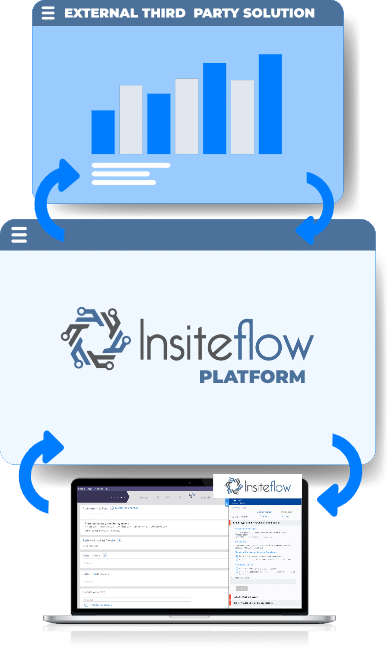EHRs and EMRs have been a part of the medical world since the 1960s and adoption was eventually incentivized by the government in 2009. The goal was and still is to improve data accuracy, support provider decision-making, and empower clinicians with information to improve continuity of care. Good intentions, but many provider organizations and clinicians will express frustration if asked if they have realized the full value of their EHR.
One complaint has been that the EHR can impact the physician-patient relationship when providers end up having to spend more with their computers rather than spending even more time on patients at the point of care. The National Academy of Sciences, Engineering, and Medicine reported in 2019 that healthcare providers spend 50% of their days on their computers, one of the primary causes of physician burnout. Even more shocking is a 2013 study that found 40% of a typical 10-hour emergency room shift was spent on data entry and 4,000 mouse clicks in the EHR.
Whether providers are inputting data into the EHR or trying to find data-driven insights from external healthcare analytics software to inform their decisions or aid in proper coding, clinicians are exhausted. Physician burnout is a real problem, and so is suboptimal patient care, proper reimbursements, and the return on investment on the EHR and third-party applications. Fortunately, technology is catching up, and provider organizations and physicians can finally reap the intended EHR benefits, thanks to an EHR decision workflow.

The Role of Interoperability in
Healthcare - and Why It’s Not
Enough
Interoperability is the capability of a product or system to interact and function with others. A critical component of an EHR that aims to consolidate disparate data into a single system. In healthcare, interoperability has been almost exclusively focused on reading and writing data to the EHR; however, in all other industries, it is much more than that, and it’s time healthcare expands its definition to include workflow.
The EHR is about driving informed decisions, but the existing EHR workflow for utilizing existing third-party solutions to improve coding, documentation and care is not ideal. Third-party data and recommendations aren’t always easy to access and use while working within the EHR.
If They Can’t Easily Find It, They Won’t Use It
Clinicians spend too much time and effort trying to access and use the insights and recommendations that could improve patient care or reimbursement, often deterring them from even trying. Some of the current EHR workflows require them to navigate outside of the EHR to external vendor websites, log in and search for a patient, close gaps in the website, and then toggle back into the EHR and manually close the gap in the EHR. Other workflows are based on alerts and lead to “alert fatigue” from the overwhelming number of alerts coming from the EHR.
As if the 85% of clinicians reporting that trying to access patient-specific insights in external tools contributes to their fatigue and feeling burned out wasn’t bad enough, all of these issues also have a direct impact on a hospital’s bottom line. The time physicians spend dealing with bill-related issues such as coding errors has a cost - $68,000 per clinician. When provider organizations invest in external, third-party vendor solutions that aren’t used, those investments are a complete loss.
Errors, missed care opportunities, wrong codes, and time requirements result in decreased patient care, physician burnout and wasted spend. A recent Wakefield Research survey for Insiteflow of 250 U.S. clinicians uncovered an astounding 98% of clinicians reported they could provide better patient care and get timely reimbursement if patient-specific insights were easier to access and use. Sadly, 94% of clinicians surveyed say their patients have been impacted by these types of insights not being easy enough to access and use while working in their EHR.
The New EHR Frontier: Workflow Interoperability

The EHR has been a game-changer for healthcare, a massive step forward for both providers and patients. Its foundation is strong, and with the evolution of technology, it is becoming even more advantageous. There is room for continued improvement; however, most notably with accessing and using insights from external third-party solutions.
The constantly increasing amount of data stored in EHR can create a problem when it is not easy to analyze the data and turn it into accessible and actionable insights. Provider organizations and clinicians need more than insights that improve patient care; they need easy access to these insights at the right time to support new decisions that improve healthcare, including patient care, care quality, patient experience, clinician experience, and reimbursement. They need a proactive and persistent user interface or notification when there are patient gaps that require their attention.
Only by including workflow interoperability can clinicians and the broader care team be empowered to make the best possible decisions to transform clinical outcomes and financial results. Workflow interoperability improves the return on investment on existing investments in EHRs, analytics and other third-party solutions, including solutions that leverage artificial intelligence and machine learning.
Understanding Workflow Integration Options
There are several solutions that attempt to streamline the EHR to make it and third-party insights easier to access and use. Let’s take a look at the traditional ones before examining a more modernized approach.

SMART App Launch
According to its website, “The SMART App Launch Framework connects third-party applications to Electronic Health Record data, allowing apps to launch from inside or outside the user interface of an EHR system.”
The clinician must proactively find the vendor button in a drop-down menu within the EHR and click on it to find out if the solution has any recommendations. Because time is short at the point of care and there’s no guarantee their efforts result in any meaningful insights, many clinicians stop searching for and clicking on these buttons.

Ribbons
Ribbons are display-only, and any decision made in the ribbon needs to then be manually entered into the EHR. Again, these manual efforts consume precious time providers could better spend elsewhere (and often do).

CDS Hooks
CDS Hooks embed additional functionality within a clinician’s workflow of an EHR. By using FHIR services, CDS Hooks offer interoperability, but not all EHRs have CDS Hooks. Users still often have to launch the third-party vendor solution from the CDS Hook.
A Better Option:
Insiteflow EHR Decision Workflow
Insiteflow EHR Decision Workflow is different and changing how hospitals and clinicians operate. It integrates with the leading EHRs, making external, third-party analytics and recommendations accessible directly within the EHR workflow.
As our solution surfaces gaps in care automatically, providers can see what’s important quickly, while they’re with the patient, during a face-to-face interaction. Clinicians get to do what they enjoy most - spending time caring for patients rather than digging through their EHR and external websites or inputting data.
Here’s how it works: Without a click or logging into third-party solutions, users are automatically notified only when there is relevant content for the end user to address. Insiteflow EHR Decision Workflow can be configured into different form factors, including a badge or a sidebar. It also writes decisions made within the user interface of a third-party solution back into the EHR, completely eliminating manual data entry.
Our revolutionary EHR
decision workflow:
• Is proactive and persistent
• Only appears when there is a gap or recommendation for the physician to address
• Eliminates the need to go find websites or buttons in drop-down menus
• Writes physician decisions directly to EHR, thereby eliminating manual data entry
• Improves user experience, adoption and financial results
With Insiteflow EHR Decision Workflow, clinicians can easily stay current with the next best action for each patient. Clinicians are empowered to improve care and reimbursement in their EHR workflow with data-driven recommendations and insights from external solutions.
Critical insights on care gaps, HCCs, risk adjustment, value-based care, clinical surveillance, and clinical documentation integrity can all be seamlessly integrated at the point of care and keep decision points. This integration makes it easier to keep up with the latest healthcare developments, such as new diseases, conditions, treatments, medications, clinical trials, care plans and best practices - within their EHR workflow. This is true workflow interoperability that can significantly reduce clinician burnout while improving the quality of care and patient relationships, ensuring appropriate reimbursements, and increasing ROI.
Want to compare the Insiteflow EHR Decision Workflow with your current solution to see how much more effective and productive your providers can be?

Compatible with top EHR systems.

